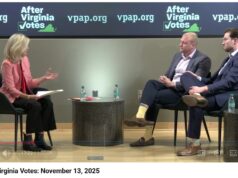by Cindy
[Note: I’ve updated this post, because my description of the final bill was mostly motivated by the floor speeches given for and against it, and I hadn’t thoroughly read the final committee version. Now that I’ve read it, I think it’s not as good as what I originally wrote. Updated information is in red.]
Today was the last full day of session, officially the eleventh hour for redistricting reform before the next Census. And the General Assembly got it done. It wasn’t perfect, and it wasn’t pretty, but they got some form of redistricting reform passed.
One Virginia 2021 has been building grassroots advocacy to fight for an independent redistricting commission since 2013. Advocates have written and called their representatives, have appeared at town halls and public events to ask about redistricting, have stood at polls on election days, have knocked doors and left leaflets. Finally, the organization set up a committee over the summer to write their own proposal, which became a Senate resolution (SJ305) sponsored once by Senator Glen Sturtevant (R-10), and a second identical version (SJ274) by Senators Emmett Hanger (R-24) and Mamie Locke (D-02). This created a citizens-only redistricting commission, similar to that adopted in California.
The same grassroots advocacy also pushed Senators George Barker (D-39) and Dick Saslaw (D-35), longtime serial gerrymanderers, to accede to the demands of the public and agree to support independent redistricting, although both said that a completely nonpartisan commission such as the 1VA2021 plan, would not pass the House, and probably not the Senate either. Saslaw, at a dinner with Brian Cannon from 1VA2021, came up with a compromise idea, a commission comprised of 8 bi-partisan, bi-cameral legislators and 8 citizens, where it would require 6 of 8 of each to agree to a set of maps. This became the Senate resolution (SJ306) sponsored by Barker and Saslaw.
These two competing bills were steered through the Senate Privileges and Elections Committee, with Chair Jill Vogel (R-27) putting in some work before the committee met to figure out where the members stood, what they would support, and to figure out how to get one single vehicle reported to the floor. As predicted, there wasn’t enough support for the 1VA2021 plan, and it failed. It was a good idea, but too much too soon for these legislators used to having the power to draw their own districts. But the Barker/Saslaw plan (SJ306) seemed to hit the sweet spot–just enough independence to the commission without totally cutting the legislators out. Senator Cosgrove (R-14) said he’d never voted for redistricting reform and probably never would again, but supported this idea. And it reported unanimously to the floor, where it passed the full Senate unanimously, and even won an amendment that added some much-needed transparency to the workings of the redistricting commission.
On the House side, with a very conservatively stacked Privileges and Elections Committee and subcommittees, reasonable reform proposals were killed instantly. The only resolution to come out was a terrible resolution (HJ615) by Chair Mark Cole (R-88), that created a completely partisan commission, and that included retaining political parity between the parties in the drawing of districts. Essentially, affixing gerrymandering into the Constitution! This bill reported out of committee on a party-line vote, and passed the House on a party-line vote.
After crossover, the Senate “passed the Cole resolution” after substituting in the Barker/Saslaw language, and the House “passed the Saslaw/Barker resolution,” after substituting in the Cole language; effectively making up turn to down and down turn to up. Each chamber then rejected the substitute and they decided to go to conference to hammer out an agreement.
Senator Vogel assigned herself, Barker, and Cosgrove (see above) to the conference committee; and Delegate Cole assigned himself, and Delegates Rush (R-07), Leftwich (R-78) and Krizek (D-44) to the committee. Here’s where we lose the transparency of the General Assembly, because no one knows what discussions were held in that committee. But at the end, the conference reported a resolution that looked about 90% like the language of the Barker/Saslaw bill. At the end, the conference reported a resolution that contained some parts of the Barker/Saslaw bill, but that had lost several important safeguard components. In particular, in the original bill, 16 citizens were randomly selected from the pool of applicants, and then 8 were chosen by a committee of retired judges. In the reported version, the Senate minority leader, majority leader, House minority leader and Speaker each choose 16, and the committee of judges selects two from each list. This is a much more partisan process.
That conference report was then up for a final vote in both the Senate and the House. The Senate once again had no problem, passing the report unanimously. But over in the House, several members of the Legislative Black Caucus now expressed concerns about the lack of explicit participation for minorities. There was no guarantee that the eight citizens would have any diversity. No guarantee that the legislators would. And, should the commission fail to produce an agreement on districts, the Virginia Supreme Court, which is not very diverse and “doesn’t seem to represent the views of the Commonwealth” would have the final say in drawing districts. (Additionally, in the original bill, the Governor had the ability to veto the maps drawn by the commission, but that was cut out of the reported version.) This provides a disincentive for the Republican members of the commission to negotiate in good faith with the Democratic members, because the fall-back is the conservative-leaning Supreme Court.
Delegate Rasoul pointed out that many details of how the commission members were picked among other things, were left to be ironed out with bills that would be written by the General Assembly next year or in the following years, and that there would be an opportunity to mandate more representation for minorities in those details. Ultimately, the conference report passed 83-15.
And so, on the 11th hour of the 11th day, the Virginia General Assembly took its first cautious steps towards redistricting reform. It is far from perfect, and it wasn’t pretty, but they made some progress against gerrymandering. Bear in mind though, this exact same resolution–word for word–still needs to pass next year’s General Assembly, a body which may consist of many different members from this year’s, and in which a different political party may hold the majority. And even if they are able to pass it again in the 2020 session, it must come before the voters November, 2020.













![[UPDATED with Jim Ryan’s Letter] In Response to Youngkin’s “Sad, Whiny” Letter to Spanberger About UVA, VA Senate Majority Leader Surovell Says He’s “truly embarrassed for Gov Youngkin…After 4 yrs he has no understanding of basic VA govt structure”](https://bluevirginia.us/wp-content/uploads/2025/11/youngkinspanuva3-100x75.jpg)